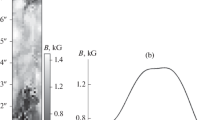Abstract
The paper draws attention to the complex structure of the fast magnetic clouds of the solar wind, which, in addition to the actual cloud body, contain a turbulent transition layer (cloud sheath) with a large and irregular magnetic field following the shock wave. The orientation of the plane of the magnetic-cloud shock wave with respect to the interplanetary magnetic field modified by the shock wave propagating in the solar wind for 33 cases of the registration of fast magnetic clouds has been calculated. The dependence of the substorm activity in the auroral zone on the level of turbulent processes occurring in the sheath of magnetic clouds has been studied. It was taken into account that the turbulent phenomena in the sheath are largely determined by the orientation of the shock-wave plane with respect to the interplanetary magnetic field. It is shown that the level of magnetic activity in the auroral zone, which is characterized by the integral AL index, increases with a decrease in the angle between the direction normal to the shock-wave front and the vector of the interplanetary magnetic field. Thus, the most geoeffective are magnetic clouds with a quasi-parallel shock wave, and the least geoeffective are those with a quasi-perpendicular shock wave. It was concluded that the intensity of turbulent processes in the cloud sheath increases with a decrease in the magnetic field penetrating the sheath, which plays a stabilizing role for turbulent magnetohydrodynamic perturbations.




Similar content being viewed by others
REFERENCES
Barkhatov, N.A. and Revunov, S.E., Neural network classification of discontinuities in space plasma parameters, Soln.-Zemnaya Fiz., 2010, no. 14, pp. 42–51.
Barkhatov, N.A., Bellyustin, N.S., Bougeret, J.-L., Sakharov, S.Yu., and Tokarev, Yu.V., Influence of the solar-wind magnetic field on the magnetosheath turbulence behind the bow shock, Radiophys. Quantum Electron., 2001, vol. 44, no. 12, pp. 915–923.
Barkhatov, N.A., Kalinina, E.A., and Levitin, A.E., Manifestation of configurations of magnetic clouds of the solar wind in geomagnetic activity, Cosmic Res., 2009, vol. 47, no. 4, pp. 268–278.
Barkhatov, N.A., Levitin, A.E., and Revunova, E.A., Classification of space-weather complexes based on solar source type, characteristics of plasma flow, and geomagnetic perturbation induced by it, Geomagn. Aeron. (Engl. Transl.), 2014, vol. 54, no. 2, pp. 173–179.
Barkhatov, N.A., Vorobjev, V.G., Revunov, S.E., and Yagodkina, O.I., Effect of solar dynamics parameters on the formation of substorm activity, Geomagn. Aeron. (Engl. Transl.), 2017a, vol. 57, no. 3, pp. 251–256. https://doi.org/10.1134/S0016793217030021
Barkhatov, N.A., Revunova, E.A., and Vinogradov, A.B., Possible cause of solar wind magnetic cloud shock waves, in Proc. XL Annual Seminar “Physics of Auroral Phenomena”, Apatity, 2017b, pp. 76–77.
Barkhatov, N.A., Revunov, S.E., Vorobjev, V.G., and Yagodkina, O.I., Studying the relationship between high-latitude geomagnetic activity and parameters of interplanetary magnetic clouds with the use of artificial neural networks, Geomagn. Aeron. (Engl. Transl.), 2018, vol. 58, no. 2, pp. 147–153. https://doi.org/10.7868/S0016794018020013
Barkhatov, N.A., Dolgova, D.S., and Revunova, E.A., Dependence of the geomagnetic activity on the structure of magnetic clouds, Geomagn. Aeron. (Engl. Transl.), 2019, vol. 59, no. 1, pp. 16–26.
Hundhausen, A., Coronal Expansion and Solar Wind, Berlin: Springer, 1972; Moscow: Mir, 1976.
Kilpua, K.J., Li, Y., Luhmann, J.G., Jian, L.K., and Russell, C.T., On the relationship between magnetic cloud field polarity and geoeffectiveness, Ann. Geophys., 2012, vol. 30, no. 7, pp. 1037–1050. https://doi.org/10.5194/angeo-20-1037-2012
Kleimenova, N.G., Kozyreva, O.V., and Schott, J.-J., Wave geomagnetic response of the magnetosphere to an interplanetary magnetic cloud that approached the Earth on July 14–15, 2000 (a Bastille Day event), Geomagn. Aeron. (Engl. Transl.), 2003, vol. 43, no. 3, pp. 299–308.
Landau, L.D. and Lifshits, E.M., Teoreticheskaya fizika (Theoretical Physics), vol. 8: Elektrodinamika sploshnykh sred (Electrodynamics of Continuous Media), Moscow: Nauka, 1982.
Manakova, Yu.V., Pekhteleva, K.A., Barkhatov, N.A., and Revunov, S.E., Space–time analysis of disturbances in the PC4-5 range during magnetic storms by correlation–skeleton method, Vestn. Mininsk. Univ., 2016, no. 1.
Yermolaev, Yu.I., Nikolaeva, N.S., Lodkina, I.G., Yermolaev, M.Yu., Catalog of large-scale solar wind phenomena during 1976–2000, Cosmic Res., 2009, vol. 47, no. 2, pp. 81–94.
ACKNOWLEDGMENTS
The parameters of the interplanetary magnetic field, solar-wind plasma, and magnetic activity indices were taken from (http://cdaweb.gsfc.nasa.gov/) and (http://wdc.kugi.kyoto-u. ac.jp/), respectively.
Funding
N.A. Barkhatov and S.E. Revunov were supported by the state task of the Ministry of Education and Science of the Russian Federation, no. 5.5898.2017/8.9. O.M. Barkhatova was supported by the Russian Foundation for Basic Research, project no. 18-35-00430.
Author information
Authors and Affiliations
Corresponding author
Rights and permissions
About this article
Cite this article
Barkhatov, N.A., Vorobjev, V.G., Revunov, S.E. et al. Substorm Activity and Orientation of the Front of a Shock Wave of an Interplanetary Magnetic Cloud. Geomagn. Aeron. 59, 398–406 (2019). https://doi.org/10.1134/S0016793219040042
Received:
Revised:
Accepted:
Published:
Issue Date:
DOI: https://doi.org/10.1134/S0016793219040042




